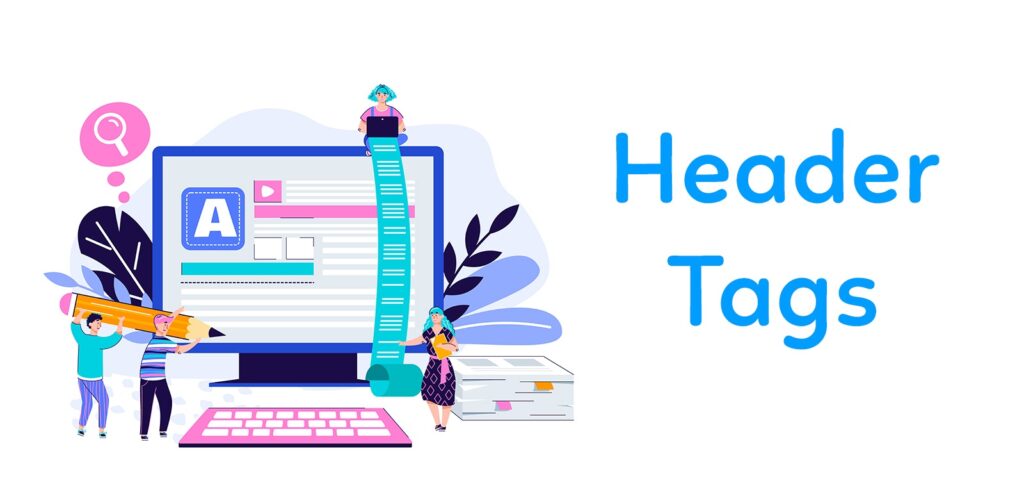Your cart is currently empty!
Header tag: How to optimize it for SEO
There’s no denying that these tags still serve an important function – for your users and your SEO. It is important to note that you want to get ranked for the long tail of the search and header tag. It plays a very important role when you are considering ranking for various keywords on a subject. In other words, it can indirectly influence your rankings by making your content easier and more enjoyable for visitors to read, and by providing keyword-rich context about your content for the search engines.
Optimizing your header tag, then your SEO will eventually get favored. Here are some tips on how to optimize your header tag for SEO.
1. Use header tag for providing structure
Your header tag provides structure and context for your article. Each header tag should give the reader an idea of the information they can glean from the paragraph text that follows below. A helpful way to think of header tags is by comparing them to a table of contents. To be more specific:
- Your H1 (Heading 1) introduces the topic your page is all about, just as the title tells the reader what a book is all about.
- The H2s (Heading 2) are akin to book chapters, describing the main topics you’ll cover in sections of the article.
- Subsequent headers, H3s (Heading 3) to H6s (Heading 6), serve as additional subheadings within each section, just as a book chapter may be split up by multiple sub-topics.
Remember, you should always use an H1 for the main heading and use H2 (Heading 2) for subheadings. You can multiple H2 tags for different sections of the content and at the same time use H3 tags for further organization. Limit until H3 because H4 (Heading 4), H5 (Heading 5) and H6 (Heading 6) tags do not have much weight as far as SEO is concerned.

2. Use header tag to break up text
A scannable article is a readable article, and a readable article is one that’s more likely to perform well in search engines. The data backs up these claims. Only 16 percent of Internet users read an article word-for-word. The rest are scanning. People simply like scannable content. When an article is scannable, users might actually stick around to read it, instead of bouncing back to Google. Plus, they’ll also be more likely to share it with their friends. While social signals aren’t a direct ranking factor, the more an article is shared, the more likely it is to naturally earn backlinks, which are a ranking factor. These things, to conclude, will lead to a better on-page user experience for the visitor, and will more likely keep your reader on the page longer.
3. Your header tag must include your keyword
As with anything Google pays attention to, that means it’s worth including keywords in your header tags. However, this does not mean you should spoon-feed each of your header tags one or more keywords at all costs. Your article may eventually be considered spam and overloaded. So, keep in mind that many of the header tags in this article contain keywords, but not all of them do. Your page should be readable first and foremost, and naturally include keywords. Your article must be designed for users, then make tweaks to optimize for Google – without sacrificing the user experience. Increasingly, SEO professionals in recent years are finding that good UX translates to good SEO.
4. Optimize for featured snippets
One place where the header tag, in general, does seem to make a positive impact on SEO is with featured-rich snippets. This effect is in two particular ways:
- The first is optimizing your header tag for a long-tail voice search keyword and then answering the query directly below using text within paragraph tags.
- The second is using subsequent, smaller headings to outline different list items. Google uses these headers to create its own bulleted and numbered lists featuring snippet results.
These two may be used separately, but they can be implemented in rich snippets altogether, which will lead to SEO optimization. For example, if you look up something such as “Web design”, then your result in your Google may include a paragraph of text beneath their keyword-optimized H1, and some all-to-answer query on the page on the text below. This will definitely optimize your header tag for SEO.
5. Only use one H1 only
The H1 is specifically used to highlight the main keyword phrase of the page. H1s are big, and they look like titles to readers. So if you continuously use H1 as your header tag, this can cause some confusion for your search bots. It is best practice to make page structure as clear as possible for all search engine bots, this way, you are helping to dictate what your page should rank for in SERPs (Search Engine Results Page). In short, just remember: Header tag elements on the page always stick out to bots, so using a heading tag without attention (more specifically, use only one H1) is actually hurting the chances of this page ranking.
6. Keep your header tag consistent
A good rule of thumb is to maintain a consistent experience for users. When a site achieves that down to the finest detail, it’s impressive. So, aiming to impress with consistent header tags is considered to be of the most importance. If you choose to use title case format, stick with that across all your pages (and vice versa if you choose sentence case). Also, keep your headings on the shorter side. A header tag is not the place to emphasize a block of keyword-rich text for Google, so treat it like a mini-title for the following section of text. For great SEO – optimization, keep headers about the same length as your title tags (70 characters or less). The more you can set up expectations for your site visitors, and then consistently meet them, the more engaged they’ll be with your site.
7. Make yours appealing
Your initial draft may have bland headers that you use to create your outline, but you should always review and revise them before publishing to make them compelling for visitors. Though your header tags make an article scannable, ideally, they don’t scan the whole way through. So, you should Intrigue your header tags to encourage visitors to linger on your site and read for a while. In large part, your H1 may dictate whether visitors bother to scroll down the page at all. To conclude, you should do your best to write one awesome H1 tag that answers the user’s search intent, and gets them excited about reading your article.
That may sum up how to optimize your header tag for SEO. It is important to remember that the use of well-structured header tags can help users and search engines alike. Search engine bots that crawl your website regularly are extra sensitive to them, so proper execution of headers is a critical step towards proper on-page SEO



